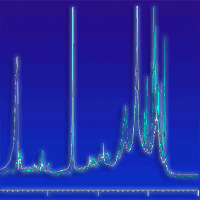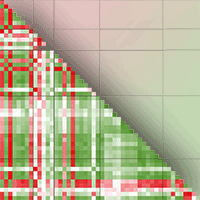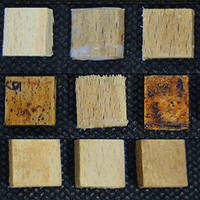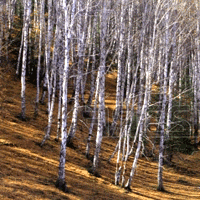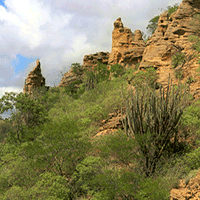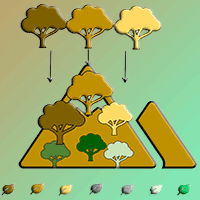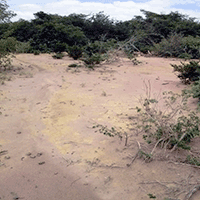The litter decomposition process depends on the litter chemical composition, especially the ratio between more labile compounds, cellulose, and the recalcitrant lignin and waxes. Their determination is crucial to predict the process, though lignin measurement presents some limitations due to drawbacks of the different methods. Thermal analysis has been successfully applied to several organic materials in order to obtain quali-quantitative information of the chemical structure of the sample. In this work TG-DTA was used in a short-term litter decomposition study of two broadleaf forest stands of contrasting ages, and the results were compared to those obtained with a chemical method (Klason’s method) commonly used to quantify cellulose and lignin. TG-DTA was applied to the litter and to the cell walls (CW) extracted from the litter, whose cellulose and lignin content was determined using the Klason’s method. When applied to litter, thermal analysis showed a weak correlation with the Klason’s method, though it allowed the detection of the dynamics of waxes, that increased during the decomposition and could influence the later stages of the process. Contrastingly, a good correlation between cellulose and lignin determined with the two methods was found when TG-DTA was applied to the CW. In this case TG-DTA, according to NMR data, also highlighted the changes in the CW chemical structure compared with that of the litters, in particular the loss of waxes and the decreased thermostability of aromatic components. Moreover, a new concept of quality of the decomposing litter, based on the balance between the energy stored in the litter and the energy needed to release it obtained by thermal analysis, was recently introduced. Samples of the old forest litter had an initial energetic balance more favorable than those collected in the young stand. At the end of the period, the decrease in litter quality was greater in the young than in the old forest samples, due to the combined effect of the higher degradation of thermolabile substances and the accumulation of more thermostable components. Thermal analysis seems to have a good potential in litter decomposition studies, as it can link structural and energetic changes during the process.
Keywords
, , , , ,
Citation
Gioacchini P, Montecchio D, Ferrari E, Ciavatta C, Masia A, George E, Tonon G (2015). Litter quality changes during decomposition investigated by thermal analysis. iForest 8: 827-837. - doi: 10.3832/ifor1297-007
Academic Editor
Renzo Motta
Paper history
Received: Mar 25, 2014
Accepted: Oct 16, 2014
First online: Mar 19, 2015
Publication Date: Dec 01, 2015
Publication Time: 5.13 months
© SISEF - The Italian Society of Silviculture and Forest Ecology 2015
Open Access
This article is distributed under the terms of the Creative Commons Attribution-Non Commercial 4.0 International (https://creativecommons.org/licenses/by-nc/4.0/), which permits unrestricted use, distribution, and reproduction in any medium, provided you give appropriate credit to the original author(s) and the source, provide a link to the Creative Commons license, and indicate if changes were made.

Breakdown by View Type
(Waiting for server response...)
Article Usage
Total Article Views: 52468
(from publication date up to now)
Breakdown by View Type
HTML Page Views: 43877
Abstract Page Views: 3010
PDF Downloads: 4116
Citation/Reference Downloads: 23
XML Downloads: 1442
Web Metrics
Days since publication: 3923
Overall contacts: 52468
Avg. contacts per week: 93.62
Article Citations
Article citations are based on data periodically collected from the Clarivate Web of Science web site
(last update: Mar 2025)
Total number of cites (since 2015): 3
Average cites per year: 0.27
Publication Metrics
by Dimensions ©
Articles citing this article
List of the papers citing this article based on CrossRef Cited-by.
(1)
Aber JD, Martin M (2002)Leaf Chemistry 1992-1993. NASA’s Accelerated Canopy Chemistry Program (ACCP), Oak Ridge National Laboratory, Oak Ridge, TX, USA.
Online |
Gscholar
(2)
Aber JD, Melillo JM (1982)Nitrogen immobilization in decaying hardwood leaf litter as a function of initial nitrogen and lignin content. Canadian Journal of Botany 60: 2263-2269.
CrossRef |
Gscholar
(3)
Aerts R (1997)Climate, leaf litter chemistry and leaf litter decomposition in terrestrial ecosystem: a triangular relationship. Oikos 79: 439-449.
CrossRef |
Gscholar
(4)
Ågreen GI, Bosatta E (1996)Quality: a bridge between theory and experiment in soil organic matter studies. Oikos 76: 522-528.
CrossRef |
Gscholar
(5)
Allen SE (1989)Chemical analysis of ecological materials (2nd edn). Blackwell Scientific Publications, Oxford, UK, pp. 169-171.
Gscholar
(6)
Anghern-Bettinazzi C, Lüscher P, Hertz J (1988)Thermogravimetry as a method for distinguishing various degrees of mineralization in macromorphologically defined humus horizons. Zeitschrift für Pflanzenernährung und Bodenkunde 151: 177-183.
CrossRef |
Gscholar
(7)
Berg B, McClaugherty C (2008)Chemical constituents as rate-regulating: initial variation and changes during decomposition. In: “Plant litter. Decomposition, humus formation, C sequestration (2nd edn)”. Springer-Verlag, Berlin, Heidelberg, Germany, pp. 115-148.
CrossRef |
Gscholar
(8)
Beyer L, Deslis K, Vogt B (1998)Estimation of soil organic matter composition according to a simple thermoanalytical approach. Communication in Soil Science and Plant Analysis 29: 1277-1297.
CrossRef |
Gscholar
(9)
Bianchi G (1995)Plant waxes. In: “Waxes: chemistry, molecular biology and function” (Hamilton RJ ed). The Oily Press, West Ferry, Dundee, UK, pp. 175-222.
Gscholar
(10)
Brinkmann K, Blaschke L, Polle A (2002)Comparison of different methods for lignin determination as a basis for calibration of near-infrared reflectance spectroscopy and implications of lignoproteins. Journal of Chemistry and Ecology 28: 2483-2501.
CrossRef |
Gscholar
(11)
Carrier M, Loppinet-Serani A, Denux D, Lasnier JM, Ham-Pichavant F, Cancell F, Aymonier C (2011)Thermogravimetric analysis as a new method to determine the lignocellulosic composition of biomass. Biomass and Bioenergy 35: 298-307.
CrossRef |
Gscholar
(12)
Couteaux MM, Bottner P, Berg B (1995)Litter decomposition, climate and litter quality. Trends in Ecology and Evolution 10: 63-66.
CrossRef |
Gscholar
(13)
Ferrari E, Francioso O, Nardi S, Saladini M, Dal Ferro N, Morari F (2011)DRIFT and HR MAS NMR characterization of humic substances from a soil treated with different organic and mineral fertilizers. Journal of Molecular Structure 998: 216-224.
CrossRef |
Gscholar
(14)
Flaig W, Beutelspacher H, Rietz E (1975)Chemical composition and physical properties of humic substances. In: “Soil Component: Organic Components” (Gieseking JE ed). Springer, Berlin, Germany, pp. 1-211.
CrossRef |
Gscholar
(15)
Francioso O, Ferrari E, Saladini M, Montecchio D, Gioacchini P, Ciavatta C (2007)TG-DTA, DRIFT and NMR characterisation of humic-like fractions from olive wastes and amended soil. Journal of Hazardous Materials 149: 408-417.
CrossRef |
Gscholar
(16)
Gallardo A, Merino J (1993)Leaf decomposition in two Mediterranean ecosystems of southwest Spain: influence of substrate quality. Ecology 74: 152-161.
CrossRef |
Gscholar
(17)
Hatakeyama T, Zhenhai IL (1998)Calibration of temperature and enthalpy. In: “Thermal analysis”. John Wiley and Sons Ltd, Chichester, UK, pp. 8-14.
Gscholar
(18)
Hatfield R, Fukushima R (2005)Can lignin be accurately measured? Crop Science 45: 832-839.
CrossRef |
Gscholar
(19)
Haw JF, Maciel GE, Schroeder HA (1984)Carbon-13 nuclear magnetic resonance spectrometric study of wood and wood pulping with cross-polarization and magic-angle spinning. Analytical Chemistry 56: 1323-1329.
CrossRef |
Gscholar
(20)
Hedenström M, Wiklund-Lindström S, Oman T, Lu F, Gerber L, Schatz P, Sundberg B, Ralph J (2009)Identification of lignin and polysaccharide modifications in
Populus wood by chemometric analysis of 2D NMR spectra from dissolved cell walls. Molecular Plant 2: 933-942.
CrossRef |
Gscholar
(21)
Jackson ML (1985)Soil chemical analysis: advanced course (2nd edn). Parallel Press, University of Wisconsin, Madison Library, WI, USA, pp. 58-60.
Gscholar
(22)
Jacob M, Viedenz K, Polle A, Thomas FM (2010)Leaf litter decomposition in temperate deciduous forest stands with a decreasing fraction of beech (
Fagus sylvatica). Oecologia 164: 1083-1094.
CrossRef |
Gscholar
(23)
Jiang G, Nowakowski DJ, Bridgwater AV (2010)A systematic study of the kinetics of lignin pyrolysis. Thermochimica Acta 498: 61-66.
CrossRef |
Gscholar
(24)
Johnson CS (1999)Diffusion ordered nuclear magnetic resonance spectroscopy: principles and applications. Progress in Nuclear Magnetic Resonance Spectroscopy 34: 203-256.
CrossRef |
Gscholar
(25)
Kelleher BP, Simpson MJ, Simpson AJ (2006)Assessing the fate and transformation of plant residues in the terrestrial environment using HR-MAS NMR spectroscopy. Geochimica and Cosmochimica Acta 70: 4080-4094.
CrossRef |
Gscholar
(26)
Kögel-Knabner I (2002)The macromolecular organic composition of plant and microbial residues as inputs to soil organic matter. Soil Biology and Biochemistry 34: 139-162.
CrossRef |
Gscholar
(27)
Kosheleva YP, Trofimov SY (2008)Characteristics of the biochemical composition of plant litter at different stages of decomposition (according to thermal analysis data). Biology Bulletin 35: 64-69.
CrossRef |
Gscholar
(28)
Kristensen E (1990)Characterization of biogenic organic matter by stepwise thermogravimetry (STG). Biogeochemistry 9: 135-159.
CrossRef |
Gscholar
(29)
Meentemeyer B (1978)Macroclimate and lignin control of litter decomposition rates. Ecology 59: 465-472.
CrossRef |
Gscholar
(30)
Melillo JM, Aber JD, Linkins AE, Ricca A, Fry B, Nadelhoffer KJ (1989)Carbon and nitrogen dynamics along the decay continuum-plant litter to soil organic-matter. Plant and Soil 115: 189-198.
CrossRef |
Gscholar
(31)
Melillo JM, Aber JD, Muratore JF (1982)Nitrogen and lignin control of hardwood leaf litter decomposition dynamics. Ecology 63: 621-626.
CrossRef |
Gscholar
(32)
Montané F, Romanyà J, Rovira P, Casals P (2010)Aboveground litter quality changes may drive soil organic carbon increase after shrub encroachment into mountain grasslands. Plant and Soil 337: 151-165.
CrossRef |
Gscholar
(33)
Montecchio D, Francioso O, Carletti P, Pizzeghello D, Chersich S, Previtali F, Nardi S (2006)Thermal analysis (TG-DTA) and drift spectroscopy applied to investigate the evolution of humic acids in forest soil at different vegetation stages. Journal of Thermal Analysis and Calorimetry 83: 393-399.
CrossRef |
Gscholar
(34)
Moorhead DL, Sinsabaugh RL (2006)A theoretical model of litter decay and microbial interaction. Ecological Monographs 76: 151-174.
CrossRef |
Gscholar
(35)
Plante AF, Fernández JM, Leifeld J (2009)Application of thermal analysis technique in soil science. Geoderma 153: 1-10.
CrossRef |
Gscholar
(36)
Plante AF, Fernández JM, Haddix ML, Steinweg JM, Conant RT (2011)Biological, chemical and thermal indices of soil organic matter stability in four grassland soils. Soil Biology and Biochemistry 43: 1051-1058.
CrossRef |
Gscholar
(37)
Reh U, Kratz W, Kraepelin G, Angern-Bettinazzi C (1990)Analysis of leaf and needle litter decomposition by differential scanning calorimetry and differential thermogravimetry. Biology and Fertility of Soils 9: 188-191.
CrossRef |
Gscholar
(38)
Rovira P, Kurz-Besson C, Couteaux MM, Vallejo VR (2008)Changes in litter properties during decomposition: a study by differential thermogravimetry and scanning calorimetry. Soil Biology and Biochemistry 40: 172-185.
CrossRef |
Gscholar
(39)
Rovira P, Vallejo VR (2000)Evaluating thermal and acid hydrolysis methods as indicators of soil organic matter quality. Communication of Soil Science and Plant Analysis 31: 81-100.
CrossRef |
Gscholar
(40)
Schultz T, Templeteon M, McGinnins G (1985)Rapid determination of lignocellulose by diffuse reflectance Fourier transform infrared spectrometry. Analytical Chemistry 57: 2867-2869.
CrossRef |
Gscholar
(41)
Simpson AJ, Kingery WL, Shaw R, Spraul M, Humpfer E, Dvortsak P (2001)The application of 1H HR-MAS NMR spectroscopy for the study of structures and associations of organic components at the solid-aqueous interface of a whole soil. Environmental Science and Technology 35: 3321-3325.
CrossRef |
Gscholar
(42)
Stout SA, Boon JJ, Spackman W (1988)Molecular aspects of the paetification and early coalification of Angiosperm and Gymnosperm woods. Geochimica and Cosmochimica Acta 52 (2): 405-414.
CrossRef |
Gscholar
(43)
Trofimov SY, Emelyanenko VI (2000)Study of thermodynamic functions of soil organic matter in the course of its decomposition. Journal of Thermal Analysis and Calorimetry 62: 69-74.
CrossRef |
Gscholar
(44)
Vallejo VR (1981)Evaluation of C:N ratio as a parameter of N mineralization. Mitteilungen des Osterreichischen Bodenkundlichen Gesellschaft 47: 71-78.
Gscholar
(45)
Wershaw RL, Leenheer JA, Kennedy KR, Noyes TI (1996)Use of
13C NMR and FTIR for elucidation of degradation pathways during natural litter decomposition and composting. I. Early stage leaf degradation. Soil Science 161: 667-679.
CrossRef |
Gscholar
(46)
Willker W, Leibfritz D, Kerssebaum R, Bermel W (1993)Gradient selection in inverse heteronuclear correlation spectroscopy. Magnetic Resonance in Chemistry 31: 287-292.
CrossRef |
Gscholar
(47)
Wu DH, Chen AD, Johnson CS (1995)An improved diffusion-ordered spectroscopy experiment incorporating bipolar-gradient pulses. Journal of Magnetic Resonance, Series A 115 (2): 260-264.
CrossRef |
Gscholar
(48)
Yang H, Yan R, Hanping C, Ho Lee D, Zheng C (2007)Characteristics of hemicellulose, cellulose and lignin pyrolysis. Fuel 86: 1781-1788.
CrossRef |
Gscholar
